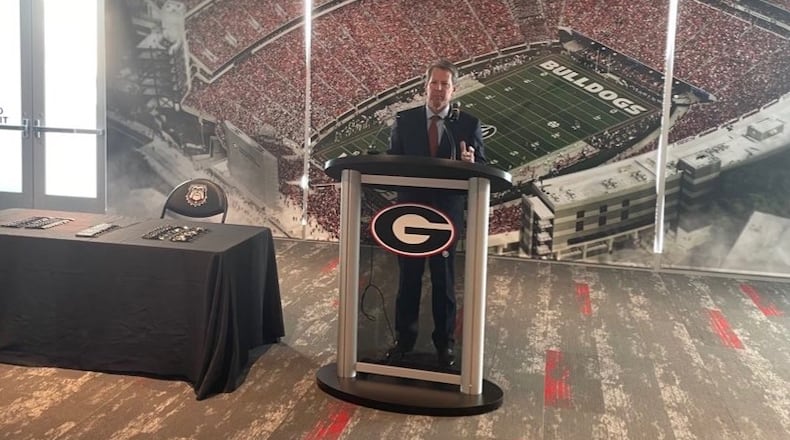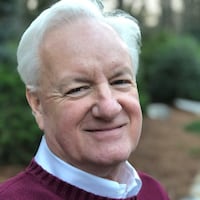Atlanta-based men’s clothing company Onward Reserve plans to be at the front of the line to pay University of Georgia athletes for use of their names, images and likenesses.
“The goal is for us to be the first company to get contracts in the hands of some student-athletes on July 1,” said TJ Callaway, Onward Reserve’s founder and CEO. “I think it could be for anything from appearances to having athletes in our catalogs to, obviously, social-media engagement. We’re excited to jump in and see what works and go from there.”
The business of college sports is about to change dramatically, and Georgia is among the states leading the way into uncharted territory.
After insisting for generations on rules forbidding college athletes from receiving compensation beyond the value of their scholarships, the NCAA is days from a new era in which athletes can make money from third parties for endorsement deals, social-media posts, autograph signings, personal appearances, camps and the like – all without compromising their collegiate eligibility.
Six states, including Georgia, cleared that path by passing new name, image and likeness (NIL) compensation laws that go into effect July 1. More than a dozen other states have passed similar laws that will take effect later, including several that could go into force this summer.
Congress is contemplating a federal law that would create a national NIL standard for college sports, but action isn’t imminent. In the interim, the NCAA is seeking to implement a temporary policy spreading NIL rights to athletes enrolled at schools in states without new laws in effect.
While the transition may be chaotic, the direction is clear and the change profound. The ever-increasing amount of money in college sports -- reflected in TV deals, coaches’ salaries and the facilities arms race -- led many politicians and, belatedly, even the NCAA to conclude that the athletes at least should be able to monetize their fame.
“It’s going to be a historic change. It’s ground-breaking,” said Drew Butler, who heads the college division of Denver-based Icon Source, a digital marketplace connecting brands with athletes.
Butler, a former Georgia Bulldogs punter, thinks a limited number of college athletes will get national endorsement deals and a “tremendous” number across all sports will get “hyper-local” deals.
“This is really a moment that is empowering student-athletes,” he said.
Butler cited a former Georgia teammate, quarterback Aaron Murray, as an example of the potential windfall: “He would have made hundreds of thousands of dollars -- there is absolutely no doubt about that – while in school (if he’d been allowed to cash in on NIL then). And he deserved it.”
Similarly, Butler said, “if Georgia beats Clemson in Week 1 this year and (quarterback) JT Daniels throws five touchdown passes, he will have tremendous NIL value.”
At UGA alone, Butler estimates “probably close to 100 athletes in all sports,” men’s and women’s, will be interested in pursuing endorsement deals.
“This is not just football and basketball,” he said, mentioning possible deals for golfers, tennis players, baseball players, swimmers and divers, track and field athletes and others.
Among the brands working with Icon Source is Onward Reserve, which sells men’s clothing, gifts and accessories at 12 company-owned stories, including one in Athens, as well as online. Well-known college athletes have been customers in the past, but NCAA rules prevented endorsement deals.
“What’s great now with the new laws, the new rules, is it’s all fair game,” said Callaway, a 2007 UGA graduate. “It was important to me that it wasn’t just a football and basketball thing. We want ‘x’ number of athletes, and I want it to be spread out among different sports.”
Callaway said UGA athletes are “the most logical place to start” for his company, but he’s also interested in deals with athletes at other schools “assuming we get some traction.”
One challenge, he acknowledged, will be figuring out how much to pay. Deals could vary widely depending on an athlete’s popularity and other factors. A study by AthleticDirectorU and research/consulting firm Navigate suggested a small number of high-profile college athletes could generate hundreds of thousands of dollars in endorsement deals, some others could generate tens of thousands of dollars, and most would see less than that.
Many local deals will be “smaller than most traditional sports sponsorships and licensing opportunities,” Callaway said. “When I think of sports relationships with brands, I think of those huge deals with Tiger Woods. You don’t often have an opportunity for a local business or a small- to medium-sized business to play in that world. … With this, the risk on the front end is low enough that it’s certainly worth giving it a shot.”
But even if most individual deals are relatively small, an athlete could collect multiple contracts, depending on a school’s market size.
“There is no cap,” Butler said. “It is unlimited.”
The revolutionary change comes amid broader questions about college sports’ business model, as reflected in a U.S. Supreme Court ruling Monday.
The high court unanimously found that the NCAA cannot place nationwide limits on academic-related benefits athletes receive. While the case didn’t directly involve name, image and likeness or pay-for-play, the decision – and particularly a concurring opinion by Justice Brett Kavanaugh – seemed to invite further challenges under antitrust laws and appeared to dissuade the NCAA from any attempt to unilaterally limit NIL activity.
“The NCAA couches its arguments for not paying student athletes in innocuous labels. But the labels cannot disguise the reality: The NCAA’s business model would be flatly illegal in almost any other industry in America,” Kavanaugh wrote.
His rebuke continued: “To be sure, the NCAA and its member colleges maintain important traditions that have become part of the fabric of America. … But those traditions alone cannot justify the NCAA’s decision to build a massive money-raising enterprise on the backs of student athletes who are not fairly compensated. … The NCAA is not above the law.”
Against that backdrop, college sports enters its NIL era.
In a 2019 meeting in Atlanta, the NCAA’s top governing body voted unanimously to allow athletes to be paid for use of their name, image and likeness “in a manner consistent with the collegiate model.” The NCAA said then that it would spend the next year or so sorting out the details. But as time went by with no concrete plan in place, some state legislatures took matters into their own hands.
Georgia’s new law was signed last month by Gov. Brian Kemp, who said during a ceremony at Sanford Stadium: “It sets Georgia on the path to accomplish something that, quite honestly, should have been done a long time ago.”
The Georgia law states that college athletes can be paid amounts “commensurate with market value” for commercial use of their name, image and likeness, but can’t be paid as a recruiting inducement to a particular school. The law requires athletes to report deals to their schools and prevents athletes from being penalized for receiving such compensation. NIL payments can’t come from the schools.
NCAA President Mark Emmert asked Congress to pass a federal law “that provides NIL opportunities for all college athletes in all the states in a fair manner” before the various state laws, which differ in some ways from one another, take effect. That timeline won’t be met, although Congress may eventually act.
Until then, some college athletes will be governed by state NIL laws, and others will not be. The NCAA in recent days has been working toward a temporary policy that could allow athletes in states without such laws to also make money from their fame -- athletes in states with NIL laws would follow those laws, and athletes in other states could have guidelines set by individual schools. The plan, like much surrounding this issue, appears fluid.
There’s no consensus in Congress about what a federal law should encompass. Some lawmakers favor narrow legislation; others want to expand the measure to include safety standards, long-term medical care and post-playing-career educational opportunities.
“To race to just an NIL bill and not address these injustices is tragic,” Sen. Cory Booker (D-N.J.), a former Stanford football player, said at a Senate committee hearing this month.
Emmert told the committee: “However well-intentioned the multiplicity of state laws are, they confuse, rather than clarify, the NIL landscape.”
The transition brings many questions. How will athletes manage their new opportunities? How will team dynamics be affected, if at all? Will companies redirect money they previously spent on marketing deals with university athletic departments to individual athletes? Will some companies shift spending from local pro athletes to local collegians? On and on.
Amid the state of flux, many businesses are poised to make offers to college athletes in July, according to Butler, an Icon Source vice president.
“Brands are ready to break down the barrier of what has not been allowed for the longest time,” Butler said. “Now, the green light is here.”
About the Author
Keep Reading
The Latest
Featured

